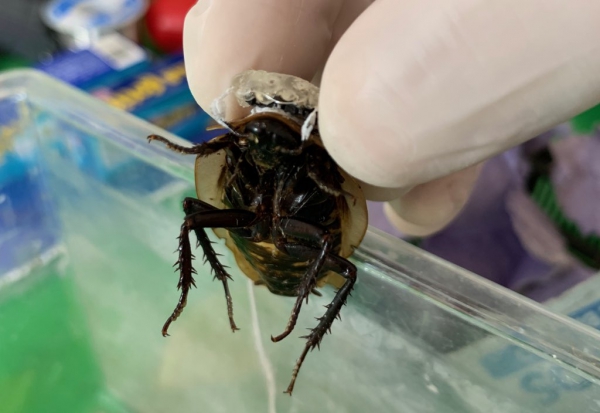Backyard Brains is now in its second year of interns from the University of Santiago de Chile (affectionately called Usach). Last year we had a project recording the ganglia of snails – and this we will continue our voyage in the world of invertebrates with an old favorite and a new favorite. Cockroaches and Clams.
The ElectrocardioCLAM
Hi, my name is Eduardo Isla, and I am in my final year as a student of biochemistry working at both USACH and UChile (Universidad de Chile). I am completing my undergraduate thesis right now as well as working for two months at the Backyard Brains Chile office. My thesis is in a quite different area (virology) working on epitranscriptomics of HIV-2. In my spare time I like to play MMORPG games as well as explore outdoor photography.

A lot of high school students like Backyard Brains’ Neuropharmacology experiment, as you can indirectly study synaptic activity in crickets, but it is time for an upgrade. First, a little bit about neurotransmitters
Did you know that neurotransmitters were discovered working on frog hearts? Everything began in 1921, when an Austrian scientist named Otto Loewi discovered the first neurotransmitter. In his experiment, he used two frog hearts. Heart 1 was still connected to the vagus nerve, and Heart 1 was placed in a chamber that was filled with Ringers solution. This chamber was connected to a second chamber that contained Heart 2. So, fluid from chamber 1 could flow into chamber 2. Electrical stimulation of the vagus nerve (which was attached to Heart 1) caused Heart 1 to slow down its heart rate. Loewi observed that after a delay, Heart 2 also slowed down. From this experiment, Loewi hypothesized that electrical stimulation of the vagus nerve released a chemical into the fluid of chamber 1 that flowed into chamber 2. He called this chemical “Vagusstoff”. We now know this chemical as the neurotransmitter called acetylcholine. It is also interesting to know English scientist Henry Hallet Dale had previously isolated acetylcholine. So, they both shared the Nobel Prize in Physiology or Medicine in 1936.
For the Backyard Brains neuropharmacology upgrade I will use some Clams, yes Clams. We eat them, but they are animals too, and believe or not they have a heart. So, I’m trying to adapt Loewi’s experiments into much simpler animals, easier to access/buy and less traumatic to work on. These experiments consist of using the Backyard Brains Heart and Brain SpikerBox to make recordings of electrocardiograms on clam hearts and the effects of different compounds. For this, first of all I need to record an electrocardiogram of the heart of clams. Afterwards, I will then treat them with various compounds to attempt to alter the heart rate. I also need to ensure that the record that we actually obtain is EKG and not movement of the electrodes. In these first few days I am trying to optimize the preparation, opening the clam while keeping the cardiovascular system intact.

The Quantified RoboRoach
Hi, my name is Claudio Moreno, and I am also in my final year working at USach in the lab of Neuroscience. I am doing my thesis in ion channel physiology, studying TRPM8 channels. TRP channels are the body’s temperature transducers, and TRPM8 is responsible for the feeling of coldness. In Chile we get cranky when the temperature gets below 40 degrees Fahrenheit (I know, nothing like Michigan), and we can thank our TRPM8 channels for that.
When not studying TRPM8 channels I enjoy going playing video games and guitar. I’ve being playing guitar for 13 years and it has been one of the best things I have done to get my mind distracted during moments of high stress. I also like to travel to different cities and countries. I have travelled to many cities here on Chile (my country), and it’s really beautiful, so if you have an opportunity to come here, trust me, you won’t regret it.
The RoboRoach is one of Backyard Brains’ original inventions where you can control cockroach locomotion by electrically stimulating the antenna, but, strangely, Backyard Brains has never systematically measured the adaptation rate. Until now. To do this experiment we are doing a bunch of RoboRoach surgeries, so we can have a high enough sample size to compare sensory adaptation rate.

Once a RoboRoach is recovered from the surgery, we can start to see if we can control our RoboRoach and measure turning responses with time! And for that we built a lego tower, which has a floating ball the cockroach walks on, along with an optical mouse to read the floating ball’s movements. When the antenna neurons are activated with electrical stimuli, they will send this electrical information (called spikes) to the cockroach brain, stimulating the neural-motor reactions. The cockroach will change direction, and we can measure this change.
The YouTube ID of </p> <p><iframe title="Quantified RoboRoach" width="500" height="281" src="https://www.youtube.com/embed/kHGl09uiYx4?feature=oembed" frameborder="0" allow="accelerometer; autoplay; clipboard-write; encrypted-media; gyroscope; picture-in-picture; web-share" referrerpolicy="strict-origin-when-cross-origin" allowfullscreen></iframe></p> <p> is invalid.This contraption allows us to measure precisely the turning of the cockroach in response to stimulation of the antenna, so we can see how it adapts over time. Now it is time to collect the data and finally say with some degree of certainty the adaptation rates across cockroaches. Like all kinds of animals with a central neural system, you can expect that neurons can adapt to a stimulus (which Backyard Brains has anecdotally observed many times in the RoboRoach). Now it is time to quantify! I am starting to get skilled at the surgery, and below you can see my first successful antenna nerve recording!
